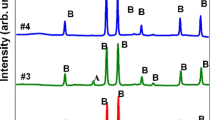Abstract
Magnetic carbon-based nanomaterials have promising applications in many fields owing to their biocompatibility and thermal/mechanical stability. This study describes a high-temperature X-ray diffraction (XRD) study of the chemical and structural transformations suffered by superparamagnetic iron oxide nanoparticles embedded in porous carbons. The nanoparticles were prepared from the decomposition of iron pentacarbonyl over porous carbons, resulting in nanometer-sized iron oxides homogeneously dispersed into the carbon matrix. The thermally induced changes in these materials were followed by in situ high-temperature XRD, using synchrotron radiation. The growing of the nanoparticles and of the carbon crystallites were first observed, followed by the reduction of the iron oxides to form α-Fe (at temperatures as low as 400 °C in some cases) and γ-Fe(C). The temperatures at which these chemical reactions occurred were dependent on the total time spent on heating and on the nature of the iron oxides formed in the as prepared materials. A noticeably large thermal expansion coefficient was also observed for the iron oxide nanocrystals. The formation of austenitic iron, stabilized by the presence of carbon, was found to be only partially reversible upon cooling.





Similar content being viewed by others
References
Cornell RM, Schwertmann U (1996) The iron oxides. VCH, Weinheim
Davis CM, Curran KA (2007) Manipulation of a Schlenk line: preparation of tetrahydrofuran complexes of transition-metal chlorides. J Chem Educ 84:1822–1823
Dyakonov AJ, McCormick BJ, Kahol PK, Hamdeh HH (1997) Magnetic materials based on iron dispersed in graphitic matrices II. High temperatures and mesophases pitch. J Magn Magn Mater 167:115–122
Fei Y (1995) Thermal expansion. In: Ahrens TJ (ed) Mineral physics & crystallography: a handbook of physical constants. American Geophysical Union, Washington, pp 29–44
Freitas JCC, Nunes E, Passamani EC, Larica C, Kellermann G, Craievich AF (2006) Structure and melting of Pb nanocrystals produced by mechanical alloying of Fe/Pb powder mixtures. Acta Mater 54:5095–5102
Fuertes AB, Tartaj P (2006) A facile route for the preparation of superparamagnetic porous carbons. Chem Mater 18:1675–1679
Hayashi K, Iwasaki K, Morii H, Xia B, Okuyama K (2001) Carbon-coated non-magnetic iron oxide particles for the substrate of multi-layered magnetic recording media. J Nanopart Res 3:149–156
Jäger C, Mutschke H, Huisken F, Alexandrescu R, Morjan I, Dumitrache F, Barjega R, Soare I, David B, Schneeweiss O (2006) Iron–carbon nanoparticles prepared by CO2 laser pyrolysis of toluene and iron pentacarbonyl. Appl Phys A 85:53–62
Jozwiak WK, Kaczmarek E, Maniecki TP, Ignaczak W, Maniukiewicz W (2007) Reduction behavior of iron oxides in hydrogen and carbon monoxide atmospheres. Appl Catal A 326:17–27
Kouprine A, Gitzhofer F, Boulos M, Veres T (2006) Synthesis of ferromagnetic nanopowders from iron pentacarbonyl in capacitively coupled RF plasma. Carbon 44:2593–2601
Lee J, Jin S, Hwang Y, Park J-G, Park HM, Hyeon T (2005) Simple synthesis of mesoporous carbon with magnetic nanoparticles embedded in carbon rods. Carbon 43:2536–2543
Oliveira LCA, Rios RVRA, Fabris JD, Garg V, Sapag K, Lago RM (2002) Activated carbon/iron oxide magnetic composites for the adsorption of contaminants in water. Carbon 40:2177–2183
Phillips J, Clausen B, Dumeslc JA (1980) Iron pentacarbonyl decomposition over grafoil. Production of small metallic iron particles. J Phys Chem 84:1814–1822
Sajitha EP, Prasad V, Subramanyam SV, Eto S, Takai K, Enoki T (2004) Synthesis and characteristics of iron nanoparticles in a carbon matrix along with the catalytic graphitization of amorphous carbon. Carbon 42:2815–2820
Schettino Jr. MA (2009) Production of iron-carbon nanocomposites from the decomposition of iron pentacarbonyl over porous carbons. Thesis, Federal University of Espírito Santo, Brazil
Xu C, Teja AS (2008) Characteristics of iron oxide/activated carbon nanocomposites prepared using supercritical water. Appl Catal A Gen 348:251–256
Acknowledgments
This study has been supported by the Brazilian Synchrotron Light Laboratory (LNLS) under proposal D10B - XPD 7639. The support of CAPES, CNPq, FAPES, and FINEP is also gratefully acknowledged.
Author information
Authors and Affiliations
Corresponding author
Rights and permissions
About this article
Cite this article
Schettino, M.A., Freitas, J.C.C., Morigaki, M.K. et al. High-temperature XRD study of thermally induced structural and chemical changes in iron oxide nanoparticles embedded in porous carbons. J Nanopart Res 12, 3097–3103 (2010). https://doi.org/10.1007/s11051-010-9905-6
Received:
Accepted:
Published:
Issue Date:
DOI: https://doi.org/10.1007/s11051-010-9905-6




